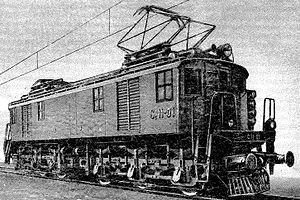SŽD series С С
| SŽD series С С (S S ) SŽD series С С М (S S M) |
|
|---|---|
|
С С 11-01
|
|
| Numbering: | С С ‑01 to ‑21 С С М ‑ 01 to ‑21 |
| Number: | 21st |
| Manufacturer: | Dinamo work , work Kolomna |
| Year of construction (s): | 1932–1934 (СС) from 1952 (ССМ, conversion) |
| Retirement: | 1968-1974 |
| Axis formula : | Co 'Co' |
| Gauge : | 1524 mm |
| Length over coupling: | 16,479 mm |
| Height: | 3875 mm |
| Trunnion Distance: | 8575 mm |
| Bogie axle base: | 2100 mm |
| Service mass: | 132.0 t |
| Wheel set mass : | 22 t |
| Top speed: | 65 km / h |
| Hourly output : | 2040 kW (С С ) 2400 kW (С С М) |
| Continuous output : | 1800 kW (С С ) 1860 kW (С С М) |
| Starting tractive effort: | 240 kN |
| Driving wheel diameter: | 1200 mm |
| Motor type: | ДПЭ-340 (С С ) ДПЭ-400А (С С М) |
| Power system : | 3 kV direct current |
| Number of traction motors: | 6th |
The locomotives of the class С С (German transcription S S ) of the Soviet Railways (SŽD) are wide-gauge electric locomotives . They were first designated as series С С 11 (S S 11). All locomotives of the series were converted to С С М (S S M).
Series С С (S S )
The Chaschuri - Sestaponi section of the Poti – Baku line of the Transcaucasian Railway in the Georgian SSR , the Surami Pass , made special demands on the performance of the locomotives and was the first long-distance railway line in the Soviet Union to be electrified with 3000 volts direct current from 1928 to 1932 . The locomotives to operate this route were initially imported from the USA due to a lack of experience with the construction of electric locomotives . In 1932 General Electric supplied eight locomotives of the series С10 (S10), later designated as С (S).
Preparations for the state-owned construction of electric locomotives had already started in 1929. The first result of these efforts was the completion of the first two engines of the type DПЭ-340 (DPE-340) with an output of 340 kilowatts at the Dinamo plant in Moscow . The Kolomna plant took over the mechanical part, working according to the plans for the C10 series. In November 1932 the locomotive С С 11-01 (S S 11-01) was completed. The designation С С was derived from "Сурамский Советский" (Suramski Sowetski), which indicates the Soviet origin and the area of operation on the Surami pass. The С С 11-01 was not the first Soviet electric locomotive, because shortly before the locomotive ВЛ114-1 (WL114-1) of a similar, somewhat lighter design, which was the prototype of the later series ВЛ19 (WL19), had been completed.
The construction of the С10 series was largely adopted for the С11. The locomotives were equipped with three-axle bogies . The characteristic design with access to the driver's cab in the front was taken over, as was the front circuit, where headlights and sockets were attached. Only the door in the middle of the long side of the locomotive body was left out on the C11.
In contrast to the ВЛ19 series, the prototype of which was initially tested, the С11 series was immediately built in series. In 1933 С11-02 to -18 were put into operation, in 1934 С11-19 to -21. From 1933 the imports of electric locomotives continued, from Italy the similar series С И 10 (S I 10), later С И (S I ), was delivered by Tecnomasio Italiano Brown Boveri , from 1934 the series production of the series ВЛ19 began. In the 1930s the designation of the locomotives was changed, the addition "11" was omitted, the final series designation was thus "С С ".
Only the first three locomotives were used on the Suramipass, the following ones were used on the Chusovskaya - Kisel line of the Permskaya seleznaja doroga , which was electrified in 1933 , also a mountain line.
Despite the similarities of the series С, С С and С И , these could not be used together in multiple traction, and С С -01 to -10 could not be used with the locomotives of the number series С С -11 to -21 in multiple traction.
Series С С М (S S M)
From 1952, all 21 С С to С С М were modernized in the course of major repairs . The engines ДПЭ-400А (DPE-400A) of the ВЛ22М series were used and the electrical structure was adapted to these locomotives. In some cases, the top speed was also increased to 70 or 80 km / h. The serial numbers remained unchanged during the renovation.
The С С М were retired from 1968 to 1974. С С М-05 was preserved in the Yekaterinburg Railway Museum, С С М-14 in the Russian Railway Museum in Saint Petersburg .
literature
- Vitaly Alexandrowitsch Rakow: Lokomotiwy otetschestvennych schelesnych dorog (1845-1955 gg.) . Transport, Moskva 1995, ISBN 5-277-00821-7 .

